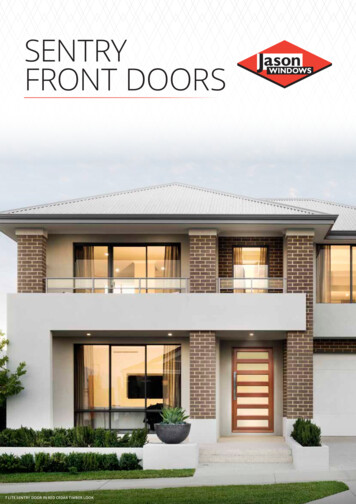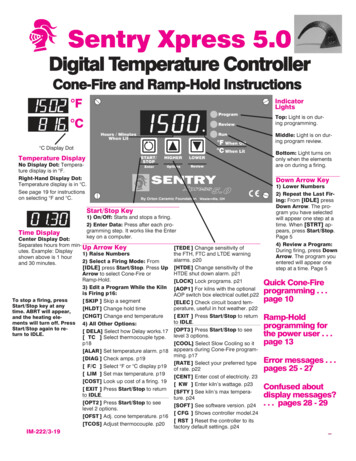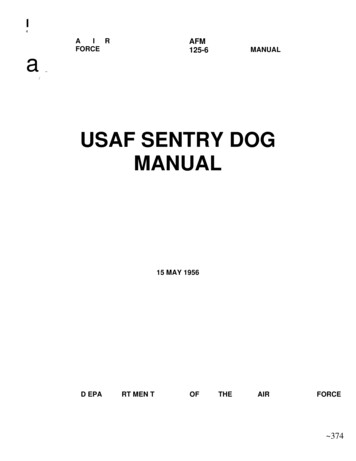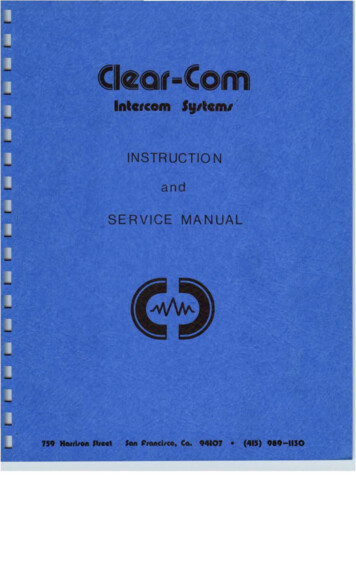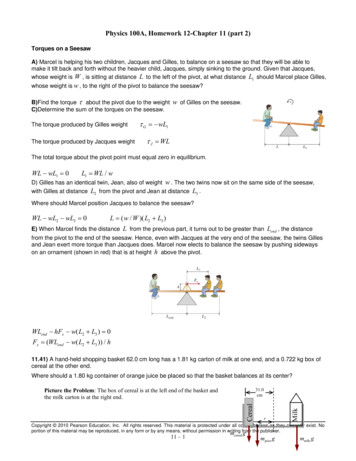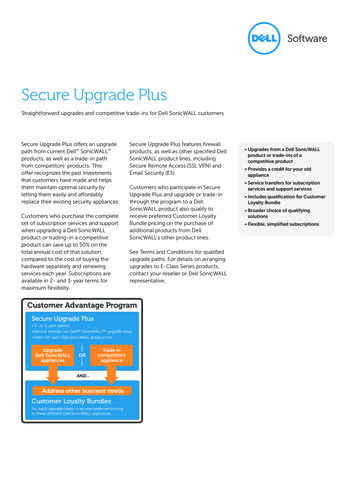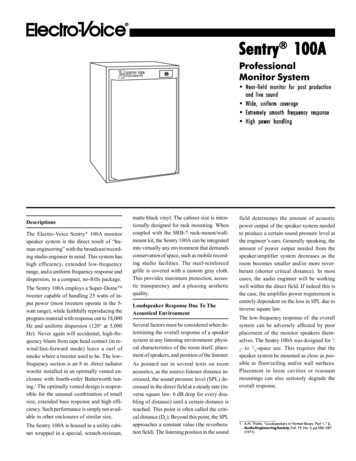
Transcription
Sentry 100AProfessionalMonitor System Near-field monitor for post productionand live sound Wide, uniform coverage Extremely smooth frequency response High power handlingDescriptionsThe Electro-Voice Sentry 100A monitorspeaker system is the direct result of “human engineering” with the broadcast/recording studio engineer in mind. This system hashigh efficiency, extended low-frequencyrange, and a uniform frequency response anddispersion, in a compact, no-frills package.The Sentry 100A employs a Super-DomeTMtweeter capable of handling 25 watts of input power (most tweeters operate in the 5watt range), while faithfully reproducing theprogram material with response out to 18,000Hz and uniform dispersion (120 at 5,000Hz). Never again will accidental, high-frequency blasts from tape head contact (in rewind/fast-forward mode) leave a curl ofsmoke where a tweeter used to be. The lowfrequency section is an 8 in. direct radiatorwoofer installed in an optimally vented enclosure with fourth-order Butterworth tuning.1 The optimally vented design is responsible for the unusual combination of smallsize, extended bass response and high efficiency. Such performance is simply not available in other enclosures of similar size.The Sentry 100A is housed in a utility cabinet wrapped in a special, scratch-resistant,matte black vinyl. The cabinet size is intentionally designed for rack mounting. Whencoupled with the SRB-7 rack-mount/wallmount kit, the Sentry 100A can be integratedinto virtually any environment that demandsconservation of space, such as mobile recording studio facilities. The steel-reinforcedgrille is covered with a custom gray cloth.This provides maximum protection, acoustic transparency and a pleasing aestheticquality.Loudspeaker Response Due To TheAcoustical EnvironmentSeveral factors must be considered when determining the overall response of a speakersystem in any listening environment: physical characteristics of the room itself, placement of speakers, and position of the listener.As pointed out in several texts on roomacoustics, as the source-listener distance increased, the sound pressure level (SPL) decreased in the direct field at a steady rate (inverse square law: 6 dB drop for every doubling of distance) until a certain distance isreached. This point is often called the critical distance (DC). Beyond this point, the SPLapproaches a constant value (the reverberation field). The listening position in the soundfield determines the amount of acousticpower output of the speaker system neededto produce a certain sound pressure level atthe engineer’s ears. Generally speaking, theamount of power output needed from thespeaker/amplifier system decreases as theroom becomes smaller and/or more reverberant (shorter critical distance). In mostcases, the audio engineer will be workingwell within the direct field. If indeed this isthe case, the amplifier power requirement isentirely dependent on the loss in SPL due toinverse square law.The low-frequency response of the overallsystem can be adversely affected by poorplacement of the monitor speakers themselves. The Sentry 100A was designed for 1/- to 1/2-space use. This requires that the4speaker system be mounted as close as possible to floor/ceiling and/or wall surfaces.Placement in loose cavities or resonantmountings can also seriously degrade theoverall response.1. A.N. Thiele, “Loudspeakers in Vented Boxes: Part 1,” J.Audio Engineering Society, Vol. 19, No. 5, pp 386-387(1971).
Sentry 100A Professional Monitor SystemSentry 100A Professional Monitor SystemSpeakerPlacement For Good StereoImagingResults of testing by Electro-Voice and others, such as Juhani Borenious2, suggest a recommended listening angle y of 60 10 foran optimum stereo image. Rather than measure an imaginary angle, exact positioningcan be obtained by placing the speakers sothat the ratio of distances h/b 0.9 0.2. Thestereo image that results is further reinforcedby the uniform dispersant characteristics ofthe Sentry 100A, particularly in the higherfrequency range, where the majority of stereo information lies. Off-axis degradation offrequency response cannot be corrected bysupplementary equalization. It is thereforecritically necessary to use a speaker systemwith uniform directivity as well as smoothon-axis response.Power Handling CapacityPower handling specifications are usuallymeaningless because they fail to indicate thenature of the test signal and/or how this testsignal relates to actual use. The 30-wattspecification for the Sentry 100A is basedon filtered random noise (FM interstationnoise and tape hiss are common forms ofrandom noise), which is fed to the speakerfor an extended time (more than 15 hours).Random noise testing is used because, likereal music and speech program material, itcontains many frequencies at once. Low frequencies, which cause large excursions ofthe woofer suspension, are present; and midbass frequencies, which contribute mainly towoofer voice-coil heating, are present aswell. Thus the woofer is simultaneouslytested for mechanical fatigue and voice-coiloverheating. Similarly, the tweeter is testedfor both mechanical and thermal failure atappropriate power levels.There is no generally accepted standard fortesting loudspeakers for power capacity. AtElectro-Voice, we expect each speaker andsystem to survive 15 hours continuous application of rated power without failure ofany component or permanent change in performance.One noise test standard, the West GermanD.I.N. 45573, specifies the random noise2spectrum. This spectrum agrees approximately with studies of voice and music spectra that appear in several textbooks on acoustics.3,4 However, only a very small percentage of the power applied to a Sentry 100Awould be in the range of the tweeter usingthis spectrum.A study done by John P. Overley of ElectroVoice5 resulted in the more realistic spectrum.The curve shows the relative levels in octave bands of average peak energy found inmany musical passages of a symphony orchestra. “Based upon peaks as short as a fraction of a second in duration . . . it representsthe approximate distribution of energy vs.frequency under highest signal conditions . . exactly those conditions which should determine the power handling requirements ofaudio components.”6 The musical passageswere taken from disc recordings that wereplayed back on “carefully equalized highquality transcription equipment.”7The test signal actually used in developmental testing of the Sentry 100A is shown inFigure 9. It is an approximation to measuredspectra of the output of a lead guitar amplifier driven into heavy clipping, and represents a worst-cast situation. The Sentry 100Awill survive 30 watts of this input for at least15 hours.for individual listening preferences, withboth boost and cut capability ( 2 dB to –4dB from nominally flat). The high-frequencycontrol is conveniently located on the frontpanel for easy access.SRB-7Rack Wall Mount KitOne of the fundamental design requirementsfor the Sentry 100A provided for the abilityto install the system in standard EIA 19 in.racks. The hardware needed for this procedure is available as an optional kit. This samekit provides for flush and angle wall-mounting as well. (Refer to the SRB-7 engineering data sheet for complete details.)A second nameplate, which can be appliedover the original label, has been includedfor those situations where mounting the Sentry 100A in an inverted position is preferred(woofer nearer to ceiling).warning:Never mount the Sentry 100A by the backpanel or by only one of the other panels.Failing to comply with this will cause thepanel to separate, resulting in the speakerfalling. For the safest method of mountingthe Sentry 100A, Electro-Voice strongly suggests using the Model SRB-7 rack/wallmounting kit.The power-handling specification applies tolong-term application of power; for short duration peaks, the loudspeaker system is capable of handling many times the ratedpower. For example: for a few milliseconds,the system will handle 10 dB peaks; if theaverage input power level were 30 watts,then it would handle peak power inputs onthe order of 300 watts.Crossover NetworkThe integral crossover network is a 12-dB/octave dual-section type, crossover occurring at 2,000 Hz. In addition, the Sentry 100Ahas a continuously variable, shelf-type highfrequency control which allows adjustment2. Juhani Boreniou, “On Loudspeaker Response in SoundControl Rooms,” J. Audio Engineering Society, preprint(1980).3. H.F. Olson, PhD., “Acoustical Engineering,” D. VanNostrand Company, Inc., Princeton, New Jersey, p. 588(1957).4. L. Beranek, “Acoustics,” McGraw-Hill Book Company,New York, p. 338 (1954).5. John P. Overley, “Energy Distribution in Music,” IRETransactions of Audio, Vol. AU-4, No. 5, Sept.-Oct.(1956).6. Ibid. p. 121.7. Ibid. p. 121.
Sentry 100A Professional Monitor SystemLimited Warranty3For warranty repair or service information, contact the service repair departmentat: 616/695-6831 or 800/685-2606.For technical assistance, contact TechnicalSupport at 800/234-6831 or 616/695-6831,M-F, 8:00 a.m. to 5:00 p.m. Eastern Standard Time.Specifications subject to change withoutnotice.Sentry 100A Professional Monitor SystemElectro-Voice products are guaranteedagainst malfunction due to defects in materials or workmanship for a specified period,as noted in the individual product-linestatement(s) below, or in the individual product data sheet or owner’s manual, beginningwith the date of original purchase. If suchmalfunction occurs during the specified period, the product will be repaired or replaced(at our option) without charge. The productwill be returned to the customer prepaid. Exclusions and Limitations: The LimitedWarranty does not apply to: (a) exterior finish or appearance; (b) certain specific itemsdescribed in the individual product-linestatement(s) below, or in the individual product data sheet or owner’s manual; (c) malfunction resulting from use or operation ofthe product other than as specified in theproduct data sheet or owner’s manual; (d)malfunction resulting from misuse or abuseof the product; or (e) malfunction occurringat any time after repairs have been made tothe product by anyone other than ElectroVoice Service or any of its authorized service representatives. Obtaining WarrantyService: To obtain warranty service, a customer must deliver the product, prepaid, toElectro-Voice Service or any of its authorized service representatives together withproof of purchase of the product in the formof a bill of sale or receipted invoice. A listof authorized service representatives is available from Electro-Voice Service at 600 CecilStreet, Buchanan, MI 49107 (800/234-6831or FAX 616/695-4743). Incidental andConsequential Damages Excluded: Product repair or replacement and return to thecustomer are the only remedies provided tothe customer. Electro-Voice shall not be liable for any incidental or consequential damages including, without limitation, injury topersons or property or loss of use. Somestates do not allow the exclusion or limitation of incidental or consequential damagesso the above limitation or exclusion may notapply to you. Other Rights: This warrantygives you specific legal rights, and you mayalso have other rights which vary from stateto state. Electro-Voice Speakers andSpeaker Systems are guaranteed againstmalfunction due to defects in materials orworkmanship for a period of five (5) yearsfrom the date of original purchase. The Limited Warranty does not apply to burned voicecoils or malfunctions such as cone and/or coildamage resulting from improperly designedenclosures. Electro-Voice active electronicsassociated with the speaker systems are guaranteed for three (3) years from the date oforiginal purchase. Additional details are included in the Uniform Limited Warrantystatement.
Sentry 100A Professional Monitor SystemSentry 100A Professional Monitor SystemFIGURE 1—Axial Frequency Response,2 Volts/3 FeetFIGURE 5—Impedance vs FrequencyFIGURE 2—DimensionsFIGURE 6—Polar Response43.8 cm(17.25 in.)30.5 cm(12.0 in.)28.2 cm(11.13 in.)FIGURE 3—Directivity vs FrequencyFIGURE 4—Beamwidth vs Frequency44
Sentry 100A Professional Monitor SystemSpecifications45-18,000 HzHalf-Space Reference Efficiency:0.6%Dispersion Angle Included by 6-dB-DownPoints, 10 Foot Microphone Distance,Anechoic Environment, One-Third Octave Bands of Pink Noise,Horizontal:250-6,300 Hz (158 32 )8,000-20,000 Hz (55 18 )Vertical:250-6,300 Hz (140 40 )8,000-20,000 Hz (52 13 )Maximum Midband Acoustic OutputPower:0.18 wattCrossover Frequency:2,000 Hz5591 dBEIA Sensitivity Rating (on axis measurement):41.8 dBLong-Term Average Power Handling Capacity (above 40 Hz):30 wattsShort-Term Power Handling Capacity (10milliseconds) (above 40 Hz):300 wattsNominal Impedance:6 ohmsMinimum Impedance:4.5 ohmsOptional Accessory:SRB-7 rack-mount/wall-mountbracketsDimensions (see Figure 2),Height:43.8 cm (17.25 in.)Width:30.5 cm (12.00 in.)Depth:28.2 cm (11.13 in.)Net Weight:12.7 kg (28 lb)Sentry 100A Professional Monitor SystemFrequency Response, 1 Meter on Axis,Anechoic Environment, Swept OneThird-Octave Pink Noise 3 dB:Sound Pressure Level at 1 Meter, 1 Wattinto Nominal Impedance, Anechoic Environment, 300-2,000 Hz Average:
Sentry 100A Professional Monitor SystemSentry 100A Professional Monitor System600 Cecil Street, Buchanan, MI 49107616/695-6831, 616/695-1304 FaxMONITORS—Professional Monitor System6 EVI Audio 1999 Litho in U.S.A.Part Number 532077—9943
selves. The Sentry 100A was designed for 1/ 4 - to 1/ 2-space use. This requires that the speaker system be mounted as close as pos-sible to floor/ceiling and/or wall surfaces. Placement in loose cavities or resonant mountings can also seriously degrade the overall response. Sentryfi 100A Professional Monitor System Ł Near-field monitor for .
